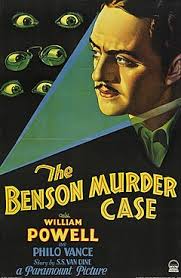
“Everybody has some motive for murdering somebody.”
Anthony Benson (Richard Tucker) was an unscrupulous stockbroker who owned The Anthony Benson & Company Stocks and Bonds. Benson has sold out all his clients. Several descend on his company looking for payback. Mrs. Paul Banning (May Beatty), her gigolo pet Adolph Mohler (Paul Lukas), the former prostitute Fanny Del Roy (Natalie Moorhead) and a bootlegger, Harry Gray (William Boyd). Unconcerned with everyone’s outrage Benson heads to his lodge in the country. Harry the bootlegger goes with him.
Not far behind are all the other victims of Benson’s financial schemes. Everyone converges on the rather large country home. All are angry with Benson and all have a motive to kill him. Someone does. The crooked stockbroker is murdered by one of his crooked clients.
The estate next door is owned by District Attorney John F.X. Markham (E.H. Calvert). During a thunderstorm the DA pays a visit to Benson. With him is Private Detective Philo Vance (William Powell). While they are sitting there waiting for Benson to return to the living room a shot is heard and Benson comes tumbling down the stairs. Vance decides to find out who killed him.
“The Benson Murder Case” was released in 1930 and was directed by Frank Tuttle. It is the third of three Philo Vance stories produced by Paramount Pictures. It is a pre-code crime drama based on the character created by S.S. Van Dine.
The movie started out fine. The pacing was good and the characters were established quickly. A good thing too since the film is only 64 minutes long. There aren’t a lot of characters and figuring out who-done-it isn’t all that difficult. The problem I had with the movie was the magic hat that Vance’s character pulled all this evidence out of.
You know who the victim is and you know who the suspects are. You even know, for the most part, why they are suspects. Some have more than one motive than others. That doesn’t matter since, how many motives do you need? What you don’t have is any clues.
Vance’s explanation for how the murder was achieved is out of left field. The execution of the crime is quite involved and required several leaps of logic to find the evidence, and how that evidence was used to commit the murder. Evidence that the audience was not privy to until Vance does his little abra cadabra at the end of the movie. Not fair.
I like murder mysteries and I look at them with a child-like wonder. I don’t try to solve the case and beat the hero to it. I’m fine with letting everything unfold in front of me and give the protagonist his day in the sun. What I don’t like is having crucial clues held back and then sprung on me in a big ‘Ta! Da!’ moment. In this case, the entire reconstruction of how the murder happened was, as far as I’m concerned, a big magic trick. I can understand not being able to put all the clues together, but there should at least BE some clues.

